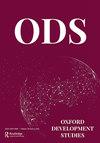中国在非洲的基础设施修复:中赞“公路财源”的教训
IF 1.2
Q3 DEVELOPMENT STUDIES
引用次数: 18
摘要
本文借助大卫·哈维的时空修复理论,对中国在赞比亚投资建设公路的热潮进行了考察。中国为基础设施项目提供的大量贷款和出口信贷,为中国向非洲“转移”剩余资本和物资提供了便利。这篇文章超越了哈维的“帝国中心主义”分析,表明中国基础设施修复的实现取决于赞比亚雄心勃勃的、债务融资的基础设施发展议程。因此,中国贷款融资的特殊性催生了“不那么公开”的采购流程,加速了赞比亚的快速债务积累。由于不断增加的债务造成了结构性限制,本文以卢萨卡-恩多拉双车道为例,分析了最近道路发展财务管理转向私人项目融资的情况。随着中国基础设施建设进入下一阶段,公私合作伙伴关系的复兴和赞比亚道路的逐步私有化标志着新一轮的强占积累。本文章由计算机程序翻译,如有差异,请以英文原文为准。
The Chinese infrastructural fix in Africa: lessons from the Sino-Zambian ‘road bonanza’
ABSTRACT This article scrutinises the surge in Chinese-funded road development in Zambia with the help of David Harvey’s theory of spatio-temporal fixes. The ‘moving out’ of Chinese surplus capital and material to Africa has been facilitated by an extensive disbursement of loans and export credits for infrastructure projects. Transcending Harvey’s analytical ‘imperio-centrism’, the article shows that the actualisation of the Chinese infrastructural fix has been contingent upon Zambia’s ambitious, debt-financed infrastructure development agenda. Particularities of Chinese loan financing have thereby fostered ‘not so public’ procurement processes and accelerated Zambia’s rapid debt accumulation. As rising debt has imposed structural constraints, the recent shift in the financial governance of road development towards private project finance is analysed with reference to the Lusaka-Ndola dual carriageway. The renaissance of public-private partnerships and the gradual privatisation of Zambian roads signify new rounds of accumulation by dispossession, as the Chinese infrastructural fix enters its next stage.
求助全文
通过发布文献求助,成功后即可免费获取论文全文。
去求助
来源期刊

Oxford Development Studies
DEVELOPMENT STUDIES-
CiteScore
2.70
自引率
0.00%
发文量
20
期刊介绍:
Oxford Development Studies is a multidisciplinary academic journal aimed at the student, research and policy-making community, which provides a forum for rigorous and critical analysis of conventional theories and policy issues in all aspects of development, and aims to contribute to new approaches. It covers a number of disciplines related to development, including economics, history, politics, anthropology and sociology, and will publish quantitative papers as well as surveys of literature.
 求助内容:
求助内容: 应助结果提醒方式:
应助结果提醒方式:


